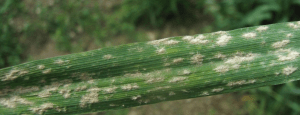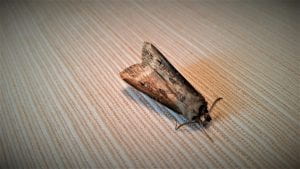Weekly NYS IPM Field Crops Pest Report
View From the Field
Welcome back!
It is that time of year again when we pull out the sweep nets, pocket our 20x hand lens, throw collection vials, shovels, soil probes, soil thermometers, tape measures, and pest-related resources into the vehicle, and head to the field. The question will be “what will we find this season?” Western bean cutworm, seed corn maggot, gray leaf spot, western bean cutworm, common ragweed, northern corn leaf blight, potato leafhopper…….. and so on? This means it is time to start the NYS IPM Weekly Field Crops Pest Report. This publication would not exist without your help and observations from the field. When we all share information it strengthens our pest-related alerts and efforts statewide.
Powdery Mildew
There have been a few reports of powdery mildew on winter small grains in western NY.
Here is a decision tool to determine if a field needs to be treated with a fungicide: https://fieldcrops.cals.cornell.edu/small-grains/diseases-small-grains/disease-management/guidelines-wheat-fungicide-decisions/
Alfalfa Weevil
There has been minor damage to alfalfa from alfalfa weevil this season. As the weather starts to warm alfalfa weevil activity will pick up.
Black Cutworm Migrations
Black cutworm migrations on weather fronts have been low with the exception of a few intense moth captures. This will pick up as we continue to get weather fronts that they migrate on. An intense catch is more than 15 moths caught in a trap in a week. The following table is the biofix date for each intense catch. We can predict using a degree-day model with relative accuracy when black cutworm larvae may be active in fields near the trap. Currently, the moths are laying eggs.
*Intense Catch is over 15 moths caught in a week.
True Armyworm Migrations
True armyworm migrations on weather fronts have been low with the exception of one intense moth capture in Pavilion in Livingston County. An intense catch is more than 15 moths caught in a trap in a week. We can predict a degree-day model with relative accuracy when true armyworm larvae may be active in fields near the trap. Currently, the moths are laying eggs.
NYS IPM Field Corn Pheromone Trapping Data
These are the number of moths caught per week in NY. This will be in a map format next week.
Alfalfa Weevil and Seed Corn Maggot Degree Days
*seed corn maggot fly free degree days are 810
*alfalfa weevil hatch degree days are 280
Clipboard Checklist
General
*Walk fields to check tile flow, check and clear drainage outlets. Look for line breaks
*Note and record location of wet areas on field maps or aerial photo for future tiling considerations and crop decisions, check for areas of soil erosion
*Pre-plant weed evaluation, timing cultivation and/or pre-plant weed management
*Watch for early season weeds: winter annuals, chickweed, henbit, field penny cress, shepherd’s purse, giant and common ragweed, purple deadnettle, lambsquarters, redroot pigweed, velvet leaf, Pennsylvania smartweed, common sunflower, quackgrass, foxtail
Alfalfa:
*Evaluate established legume stands for winter damage (thinning stand, frost heave, brown root rot), determine average alfalfa stand count adjust crop plans if necessary
*Monitor for alfalfa weevil
*Monitor new seedings for Pythium blight and Phytopthora Root Rot.
*Monitor for Alfalfa Snout Beetle (In Oswego, Jefferson, Cayuga, Wayne, Lewis, St. Lawrence, Clinton, Essex, and Franklin counties)
Small Grains:
*Monitor winter grain fields for over wintering survival (snow mold and other cold injury issues), weed issues (such as winter annuals, corn chamomile and chickweed), growth stage, number of tillers
*Check stands for soilborne virus diseases, Wheat spindle streak mosaic and Soilborne wheat mosaic, check for signs of powdery mildew or other maladies, cereal leaf beetle, weed escapes, goose damage
Corn:
*Prepare land and plant corn as conditions allow
*Pre-plant weed evaluation, timing cultivation and/or pre-plant weed management
Soybeans:
*Prepare land and plant soybeans as conditions allow
*Pre-plant weed evaluation, timing cultivation and/or pre-plant weed management
Pastures:
*Check and mend fences as needed.
*Check crop growth
*Monitor fields for invasive species, plants harmful to livestock
*Review/Plan rotation system
Equipment:
*Remove / clean soil and crop debris from equipment
*Arrange for custom weed control or check your own application or cultivator equipment for repairs.
*Carry appropriate / necessary NYS DEC and EPA required documents: (pesticide applicators license, pesticide labels, MSDS sheets, etc.) with application equipment
*Calibrate:
-planting equipment – maintain records on planting rate per field
-manure spreaders – maintain records on amount spread per field
-pesticide application equipment – Check nozzles, pumps, etc., recalibrate pesticide application equipment before use.
Storage:
* Check stored grain bins for temperature, moisture and signs of mold and insects. Aerate, core, transfer grain or treat as necessary
*Check forage allocation and anticipate feed program adjustments as forages from previous year are used up
*Plan where forages should be stored for optimum allocation next feeding season
Dairy Cattle:
*Clean around feeding rings, feed bunks and water sources removing spilled feed and undisturbed organic matter that is favorable fly breeding habitat.








